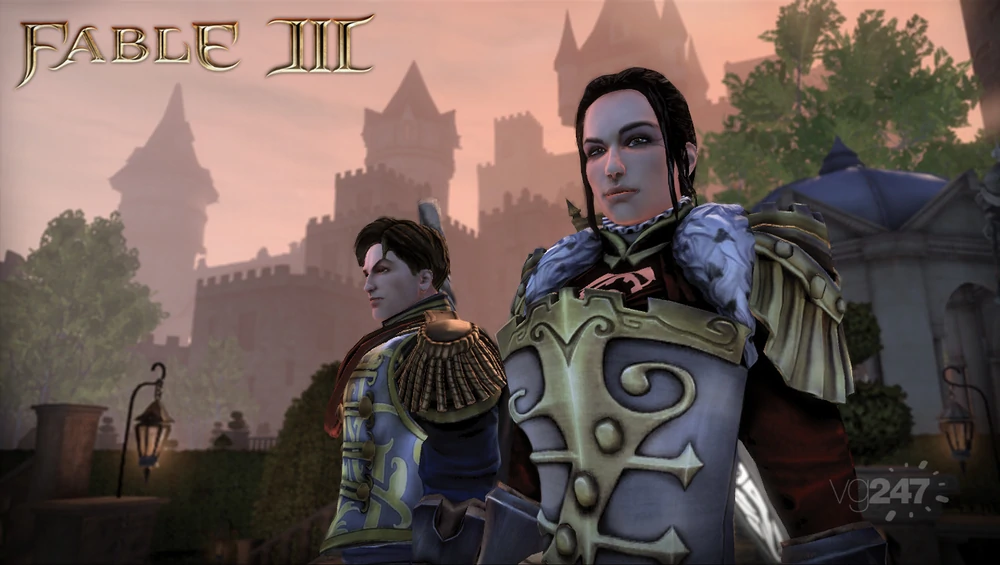Fable III is the latest in the character-morphing RPG from Lionhead Studios available on both the Xbox 360 and PC. In the continuing story of the heroes of Albion, Fable III puts you in charge of the young prince or princess who, after witnessing their brother’s cruelty, escapes the castle to gather allies and associates to take the throne from their tyrant brother and then to rule the land as the hero they have grown to be.
When it comes to graphics and sounds, things have been improved for Fable III. Same goes for the near-endless amounts of scripted conversations, with a whole bevy of voice actors and actresses having joined the ranks. Zoe Wannamaker and Stephen Fry return from Fable II and are joined by John Cleese, Ben Kingsley, Simon Pegg, Sean Pertwee, and Jonathan Ross, among many others.
The Fable III Plotline
Fable III is set 50 years after the conclusion of Fable II. The Hero of Fable II is your mother (I’m not sure whether my Fable II saved game has been read and this has been changed accordingly or whether it is predetermined), who has since died and left your tyrannical brother in charge of Albion.
Albion itself has also changed, with the land moving into an Industrial age with smoking factories and steam power. After a traumatic event you realise that your brother has gone too, far so you flee the castle to organise a rebellion and to take Albion’s throne for yourself.
After leaving the castle with your combat trainer, Sir Walter Beck, and your Butler, Jasper, you travel the land of Albion looking for other people to join your rebellion.
Specifically,
- Sabine and the Dwellers, a travelling village of nomadic people living in the mountains.
- Major Swift and Ben Finn from the Royal Army, who have been stationed in an old fort being attacked by Hollow men.
- Page, who commands the “Bowerstone Resistance”.
- And Kalin, the leader of Aurora whose city has since been destroyed by ‘the darkness’.
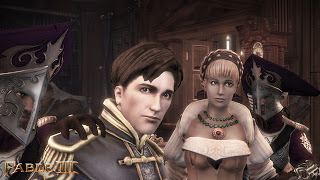
Once you have taken the throne, it is at this point that Fable III takes on a different take completely. Once you are in charge of Albion you have full accountability for the land, its people, and their survival. At this point your decisions become much bigger with larger ramifications than in the beginning part of the game.
Doing what’s right for a small group of people might actually damage the long-term goal of the land. Do you keep your promises to your allies, but drain the kingdom’s coffers? Or do you break every promise you’ve made and exploit the people; being a worse tyrant than your brother, but being in a better place to defend the land?
It is a welcome change to the usual format. As I was playing, I actually had to stop and think about my actions. After slavishly keeping the first few promises and doing what was right, the kingdoms treasury was about 500 thousand gold in debt.
The next decision came up and I knew I needed to raise some cash but I just couldn’t bring myself to agree to set up a new child labour factory. I set up the school and ‘Whoops!’ now I was 1 million gold in debt. The people loved me but I knew I couldn’t keep hemorrhaging money like this for long.
Gameplay
There have not been many large changes to the gameplay for Fable III, but it was not really broken to begin with. Some tasks were probably a bit more laborious than many would have liked them to be, but these have in most cases been improved (or removed altogether).
The questing element remains very much the same; within the game is the standard-variety bag of quest-givers who want you to do their dirty work for them, whether it’s rescuing their child, finding a lost book, or clearing a dark dungeon from a variety of oogly-booglys.
Questing is also now integrated into how you improve your relationships with Albion’s citizens. Before anyone will be your friend, best-friend, or lover you will need to do a task for them. At the earlier stages of a relation they will usually just want you to go and fetch or deliver something for them. In the later stages of a relationship you may need to offer them a specific gift or, in the case of romance, take them on a date.
Hand-holding is Fable III’s answer to the follow system utilized in Fable II. Previously, you selected the follow action and they would just run behind you until you dismissed them. Now, you can literally take a citizen by the hand and lead them to wherever you want them to be. Luckily, in Fable III taking more than one person anywhere isn’t required, as you can’t move any more than one person by hand-holding.
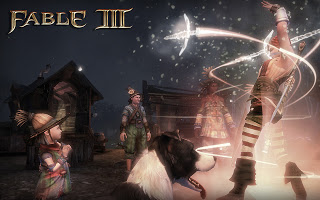 The ‘Blades’ Spell
The ‘Blades’ Spell
The Combat in Fable III remains relatively unchanged since Fable II. There are still three types of combat; melee, ranged and magic.
Out of the three styles, Magic is the one that has changed the most. Spellcasting is performed by way of a gauntlet given to your character very early in the game. As you increase the skill of your character via the Road to Rule (explained below) you can unlock access to a number of other gauntlets each controlling a different spell (Fire, Frost, Shock, Lightning etc.). There is also an ability that allows you to equip two different spell gauntlets at once. Wearing two gauntlets allows you to cast two different types of magic at the same time, with different combinations of magic having different effects.
The decisions your character takes are now a lot less ambiguous. The good decision will have a saintly glow around it, whilst the evil decision is surrounded by demonic flames.
Of course, you could argue that a lot of the decisions you are faced with now are too black-and-white and that no thought is required. Although, I think that by removing the ambiguity in the choices you are more informed about the decisions that you make. There were many occasions whilst playing Fable II where I made the wrong decision as I misunderstood what the options meant.
If you wanted a break between all the fighting you could always think about getting married and raising a family. As before, you can get married multiple times and have a myriad of kids from a number of partners, not to mention having as many illicit affairs as your character can handle.
New Interface
The biggest bane in Fable II was the horrendously multilayered and tiresome menu system you had to go through when you wanted to change your look, arrange your spells, read books, or, in fact, do anything that wasn’t immediately action-related.
Thankfully, this has been completely reinvented for Fable III. Your hero’s Sanctum, known as… well… “The Sanctuary,” can be visited at any time. It is here that you have access to a multitude of rooms, an Armoury, a Dressing Room, a Treasury and a Multiplayer Options room.
Visiting the Armoury will allow you to look at and change your weapons. In the Dressing Room you can change not only what your character wears, but dye your clothes or change your hairstyle and tattoos. The Treasury provides details of all your money-making (and spending exploits) while the Multiplayer room, surprise-surprise, shows you all your multiplayer options.
Another part of the Sanctuary is a large map of Albion that takes the pride of place in the middle of the room. By using this map you can travel to any part of the world that you have previously been to. This is instant, so you won’t find yourself wasting endless amounts of (Albion) time travelling to and from places.
Character Progression
As you progress through Fable III you travel along what is called the “Road to Rule.” The Road to Rule is a road set on an ethereal plane which provides an indication of your progress towards being the King or Queen of Albion.
As you perform heroic actions around Albion you gather Guild Crests. It is these Crests that are then spent on the various chests along the way on the Road to Rule. Some of these chests will increase combat skills, others will open interaction options or the ability to own shops and houses. How you spend your Crests (in nearly all cases) is up to you.
Body Morphing
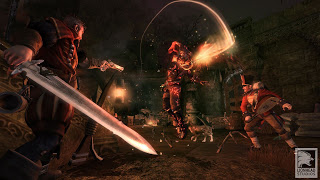 Like its predecessor, Fable III morphs your character depending on his or her actions.
Like its predecessor, Fable III morphs your character depending on his or her actions.
Although, this time around the physical changes are a lot less dramatic. Increasing your skills in Ranged combat will still make you taller, Melee combat will still make you more muscular, etc. Yet, this is no longer done to the same exaggerated extent.
Similarly, with purity and corruption, the good and evil: you will not grow demonic horns no matter how evil you become and neither will a glowing halo appear when you take a more saintly path. It adds a higher level of reality and believability to the changes.
One of the nicest additions to the game is the morphing of your weapons. Not only do your weapons become sharper or heavier with increased skill, but they will also change depending on a variety of both combat- and non-combat criteria.
For example, if you accumulate enough money your weapons will become golden. Kill enough innocent humans and your weapons will drip blood. I have also heard stories that your weapon can also change if you get enough people to engage in group activities with your character, although I haven’t seen this first-hand.
Earning Money
The Jobs have returned in Fable III and been given a slight tweak but remain fundamentally the same. Woodcutting and Bartendering have gone and been replaced with Pie Making and Lute Playing (called ‘Lute Hero,’ presumably as an homage to the Guitar Hero franchise.)
The principle remains very similar in all three games: you have to push the correct buttons at the right time. With each successful attempt the gold multiplier increases, and the speed of the sequence and gold reward increases until a mistake is made, and the multiplier resets back to 1.
The greatest gold multiplier you can have is capped at x10, but the gold you can earn is higher. As with all the other skill increases, these are purchased on the ‘Road to Rule’. The higher the skill, the more complex the job becomes, but the rewards also become much higher until you can earn over 1000 gold per successful job.
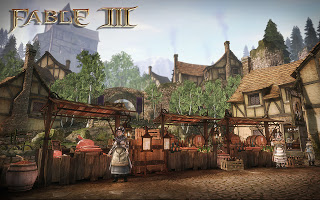 You are still able to buy houses and shops. Although, now any houses you rent out will need upkeep and repairs for the house. This is not done automatically, so if you do plan on becoming a good landlord you’ll need to spend your gold on this or tenants may soon stop paying rent.
You are still able to buy houses and shops. Although, now any houses you rent out will need upkeep and repairs for the house. This is not done automatically, so if you do plan on becoming a good landlord you’ll need to spend your gold on this or tenants may soon stop paying rent.
It is worth noting that you also no longer receive money whilst offline, but you do still receive a continuous drip feed of gold every 5 minutes depending on the properties you own.
Conclusion
So far Fable III is just as good as its previous versions. It is not a difficult game: I am already ruling Albion and I have only had the game for around 4 days, so I’m rather glad I bought it used. £34.99 for a game I’ll complete in less than a week is a little steep.
Although, there is certainly a good level of replay value. I already know I have royally (literally) screwed this one up and should have stocked up more cash before becoming a king. Plus, I want to replay as an evil king and really watch the world burn.
Fable III looks nice and sounds nice. There’s a lot to do and many ways of doing it.
Will there be a Fable IV? Probably not as, let’s be honest, the next Fable game would set the timeframe to be around 1940-50’s and I’m not sure I’m ready for my hero to be running around dressed as Elvis or Glen Miller. Then again…
(You can get the game on Microsoft’s Store or on Amazon.)
